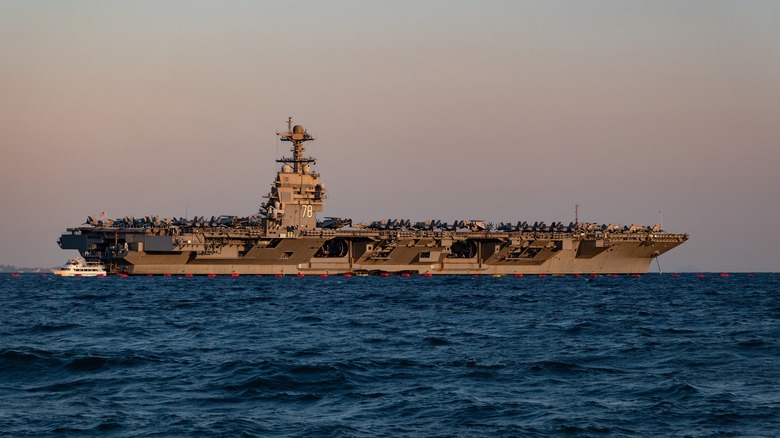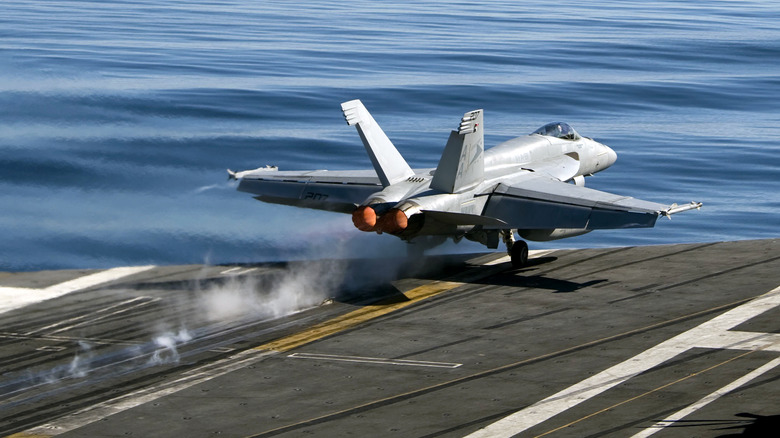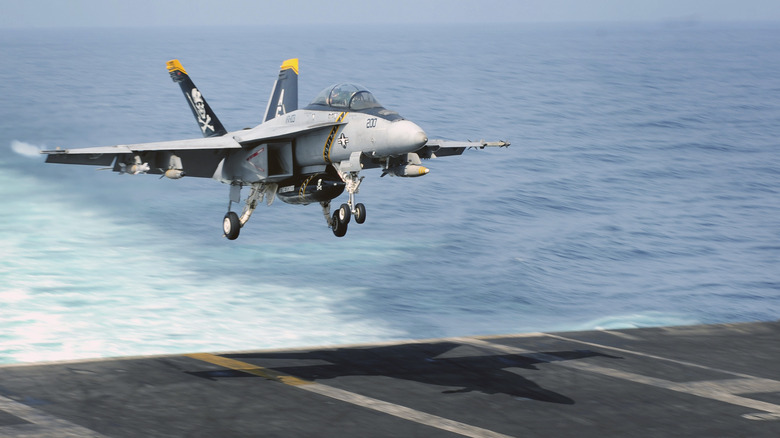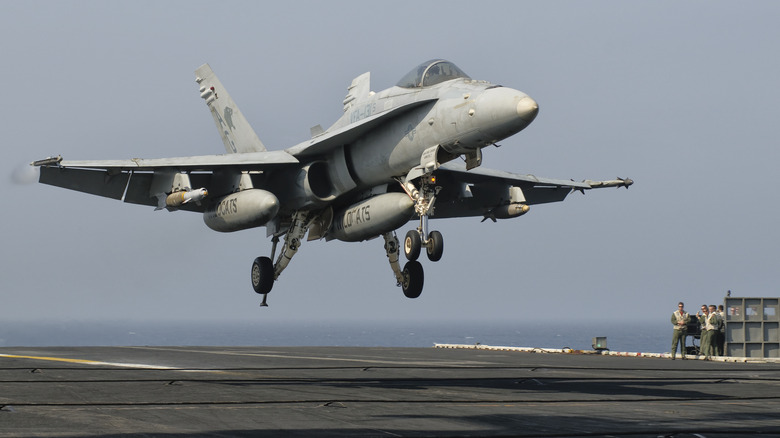Jet Aircraft Carriers Would Be Impossible Without These Genius Inventions
Famed 18th-century satirist Jonathan Swift was famously quoted as stating, "He was a bold man who first ate an oyster." The same should probably be said about the first pilot who first flew a jet plane off the deck of an aircraft carrier. Even more so for those who brought a jet in for landing, though "bold" may not quite cover the level of daring involved with landing an aircraft full of jet fuel on a moving target in the middle of the ocean. While the first pilots to fly off a boat did so in propeller-driven planes, the rise of jet-powered aircraft made flying to and from a carrier all the more perilous.
In fact, it would be virtually impossible for a pilot to safely fly a jet off of or back onto the deck of an aircraft carrier without decades-worth of technological innovations for both the jet-powered planes and the cruise ship-dwarfing floating fortresses they fly to and from. Of course, arguments could be made that, among the many innovations that have allowed jet aircraft carriers to become a functional — if not a vital addition in the realm of modern warfare, the invention of the steam-powered catapult, the development of angled flight decks, and the development of the mirrored landing system were the real game-changers. Here's a look at three of the genius inventions that have helped make jet aircraft carriers possible.
Steam powered catapults help jets achieve necessary take off speeds
Despite jets being able to accelerate faster than propellor-driven planes, the aircraft taking flight in the years following World War II were struggling to generate enough upward thrust and airflow over the wings to comfortably take flight from the runways of most of the era's aircraft carriers. The issue was further compounded by the weight of jet-powered craft, which required the creation of far more thrust for flight than prop planes. As the U.S. Navy doubled down on the use of both jet planes and the carriers they'd need to launch them from sea, it couldn't solve the problem of getting the craft into the air safely.
Catapult devices had, of course, been in use on carriers prior to the jet age. But the hydraulic devices and their accompanying wires were not strong enough to aid in getting jets up to proper take off speeds, and the gun-styled catapults the Navy had developed were proving ineffective. Thankfully, the Royal British Air Force was working on the catapult problem on the other side of the pond and was already having success with their steam-powered build.
It was British engineer C.C. Deville who designed the catapult, developing a way for the device to generate power from the steam created by a carrier's boiler. The U.S. Navy was impressed by the design, borrowing the prototype to test out on its carriers. By 1954, the Navy had its own working model of the steam-powered catapult and was soon enough using the ingenious device to launch fighter jets from the decks of its own aircraft carriers.
Angled flight decks made it easier for jets to land
These days, the U.S. Navy is catapulting its jets into flight with even more forward-thinking Electromagnetic Aircraft Launch Systems (EMALS), waving goodbye to steam builds with the launch of the U.S.S. Gerald R. Ford aircraft carrier. After solving the issue of getting jets into the air, engineers started tackling an equally complex problem of making it safer for them to land.
Jets were, after all, considerably faster and heavier than the piston-driven builds that preceded them and coupled with a dramatically different swept-wing design, jets were landing harder and struggling to stop on straight flight decks. Those issues were, in turn, also making it harder for other planes to taxi, take off, and land. The problem required another elegant solution, the angled flight deck, an ingenious concept that ultimately led to a complete redesign of a carrier's flight deck.
In principle, the concept was simple, with carriers now essentially boasting two separate runways, one straight for takeoff and another slightly longer one angled off the straightaway for landing. Both the U.S Navy and British Royal Navy were testing the so-called "axial deck" in the early 1950s, with both factions encouraged by what they were seeing, particularly as the radical design change would allow for planes to be taking off and landing simultaneously. With those jets landing at a completely different angle than planes taking off, sight lines became easier for approaching pilots to read, and with the landing strips also slightly lengthened, the possibility of dangerous miscues was greatly reduced for carriers in every naval fleet in the world.
Mirror landing-signal systems essentially light a pilot's way home
Pilots have continued to navigate some of the world's most iconic jet planes up and back down again with ease. As you might've guessed, they've been aided in that endeavor by another ingenious invention, the mirror landing system. This is another major aircraft carrier innovation birthed by Britain's Royal Navy engineering crew circa the 1950s, and it's proved to be a legitimate life-saver for pilots and flight crews in the decades since its invention.
Like the angled flight deck, the mirror landing system was an innovation born of necessity, and created in the need to help pilots safely guide their high-powered jets back to the deck of a carrier. As with the angled flight deck, the mirror landing system was also a relatively simple, if elegant, solution to a genuine problem.
In essence, the mirror landing system is as simple as it sounds, with crews casting light into a large concave mirror on the flight deck to light a pilot's way home — a method that provides a clearer glide path to the flight deck than any other method to date. Relative simplicity aside, the mirror system would be nowhere near as beneficial, or even functional, without the aid of a gyroscope, which keeps the light itself on the correct glide path as the carrier rises and falls in the waves. The mirror landing system has proven so successful it's been adopted by carrier crews the world over. And yes, it is also, in fact, where the phrase "I have the ball" originated.



